
 There are a lot of panels I’m looking forward to at next week’s Country Radio Seminar in Nashville, February 11-13. In recent years, our remaining conventions have sometimes wanted to talk about almost anything else. This year, there are at least five panels on some combination of charts, streaming, and the radio/label relationship. Those topics are often intertwined. This year, they’re particularly unavoidable.
There are a lot of panels I’m looking forward to at next week’s Country Radio Seminar in Nashville, February 11-13. In recent years, our remaining conventions have sometimes wanted to talk about almost anything else. This year, there are at least five panels on some combination of charts, streaming, and the radio/label relationship. Those topics are often intertwined. This year, they’re particularly unavoidable.
Those five panels delve into the amount of music coming from beyond Music Row, the increased presence of coastal labels in Nashville, the increased amount of music shared between Country and CHR, what “Mainstream Country” means now, and, in particular, how and when Country radio should acknowledge streaming.
The fifth and final panel is called “Evolving the Playlist: F*#@ the Format.” (The word in question is not “flush,” but I didn’t want my headline to end up in your SPAM filters.) The description encourages programmers to “learn how to exploit huge moments in the genre by adapting your approach to add dates, charts, sonic trends, brand support and more.”
To some extent, that’s already happened. One of the panelists is Audacy regional VP/programming Drew Bland. In October, prompted by a Ross on Radio article about whether CHR labels were working midchart songs too long, asked why Country songs like Zach Top’s “I Never Lie” and Riley Green’s “Worst Way,” both with fast-developing streaming stories, were still waiting their turn at radio behind current, less active singles.
Since then, prompted, in part by support from Audacy’s Country stations, both those songs are scaling the charts sooner than they might have. That meant that Green’s “Damn Good Day to Leave” peaked at No. 7 (he had just come off a duet No. 1 with “You Look Like You Love Me” that had already streamed past the intended hit). Top’s “Sounds Like the Radio” was pulled at No. 12, rather than new label Leo 33 waiting to at least get its first single into the top 10.
Both those decisions represented a change from chart business as usual. A few years ago, superstar singles started to find a consistent exemption from the 40-50 weeks that could go to working a single title at Country radio. Songs like “You Look Like You Love Me” or Koe Wetzel & Jessie Murph’s “The High Road” were confirmation that a second, faster path now existed for reaction records by non-superstars with streaming stories.
So do we need to flush the format (or worse)? And are we really talking about the format or the chart game? For the past few years, I’ve usually gone into Country Radio Seminar, and always come out of it, with an appreciation for the record/radio relationship in Country, especially as it crumbles elsewhere. I once resented the amount of time that went into working some passive titles. Once there were more reaction records, I was happy for the balance. Also, for the amount of music in play, particularly compared to CHR.
Both the Green/Langley and Wetzel/Murph duets are reminiscent of the Country radio I grew up with, where fast-breaking reaction records were common. In that Country radio, a No. 7 single also read as a solid hit to me, and No. 12 was pretty good for a new artist, especially if it set up an even bigger song. I’m glad if we’re getting away from the “customer service survey” approach to the charts, where anything other than No. 1 isn’t acceptable.
That said, most of the panel descriptions essentially ask a similar question of radio: “How can we help you become more comfortable with streaming data?” I’m glad fewer PDs are still dismissing streaming data as “the other,” but that question lands differently if you’ve seen Top 40 labels and PDs become almost entirely dependent on streaming data, and having fewer, not more hits as a result. Country is far healthier because both streaming and callout are still influences.
For the same reason, I’m hoping the influx of both artists and labels from beyond Music Row continues to refresh Country but doesn’t obliterate that balance. I’m also hoping that it doesn’t make the product situation at Top 40 any more severe. If coastal labels devote further attention to Country, does it make them less inclined to create pop hits that don’t at least feature Jelly Roll as a guest artist?
I’m happy for the multi-format hits that Country and Top 40 have created together. I’ve noticed that, after the crossover summer of 2023, Top 40 radio is generally happier to play a record that radiates from streaming to both formats simultaneously than they are one that crosses from Country to Top 40 (e.g., Morgan Wallen’s “Love Somebody”). I’ll be curious if the mostly-CHR panelists on Friday’s “We’ve Got Some Help” are doing that on purpose.
I have thought some of these things about Country radio going into CRS before. At the rate that things are evolving, I’m expecting my POV may well be different in 10 days. I’m looking forward to reporting back to you from and after the panels, as well as from Thursday morning’s CRS Research Presentation, If you’re at CRS, I’m excited to see you there. If not, look for reports @rossonradio next week.
